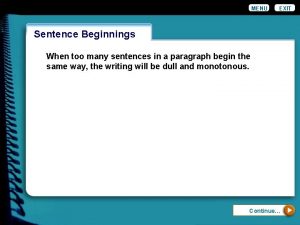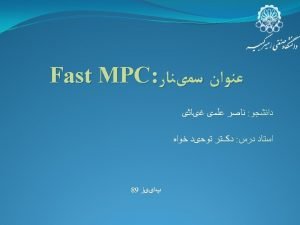Lesson planning and preparation VARYING LESSON COMPONENTS Tempo



- Slides: 3

Lesson planning and preparation

VARYING LESSON COMPONENTS • Tempo Activities may be brisk and fast-moving (such as guessing games) or slow and reflective (such as reading literature and responding in writing). • Organization The learners may work on their own at individualized tasks; or in pairs or groups; or as a full class in interaction with the teacher. • Mode and skill Activities may be based on the written or the spoken language; and within these, they may vary as to whether the learners are asked to produce (speak, write) or receive (listen, read). • Difficulty Activities may be seen as easy and non-demanding; or difficult, requiring concentration and effort. • Topic Both the language teaching point and the (non-linguistic) topic may change from one activity to another. • Mood Activities vary also in mood: light and fun-based versus serious and profound; happy versus sad; tense versus relaxed. • Stir-settle Some activities enliven and excite learners (such as controversial discussions, or activities that involve physical movement); others, like dictations, have the effect of calming them down. • Active-passive Learners may be activated in a way that encourages their own initiative; or they may only be required to do as they are told.

GUIDELINES FOR ORDERING COMPONENTS OF A LESSON 1. Put the harder tasks earlier • On the whole, students are fresher and more energetic earlier in the lesson, and get progressively less so as it goes on, particularly if the lesson is a long one. So it makes sense to put tasks that demand more effort and concentration earlier on (learning new material, or tackling a difficult text, for example) and the lighter ones later. Similarly, tasks that need a lot of student initiative work better earlier in the lesson, with the more structured and controlled ones later. 2. Have quieter activities before lively ones • It can be quite difficult to calm down a class particularly of children or adolescents who have been participating in a lively, exciting activity. So if one of your central lesson components is something quiet and reflective it is better on the whole to put it before a lively one, not after. The exception to this is when you have a rather lethargic or tired class of adults; here stirring activities early on can actually refresh and help students get into the right frame of mind for learning. 3. Think about transitions • If you have sharp transition from, say, a reading-writing activity to an oral one, or from a fast-moving one to slow one, devote some thought to the transition stage. It may be enough to frame by summing up one component in a few words and introducing the next; or it may help to have a very brief transition activity which makes the move smoother. 4. Pull the class together at the beginning and the end • If you bring the class together at the beginning for general greetings, organization and introduction of the day programme, and then do a similar full-class rounding-off at the end: the contributes to a sense of structure. On the whole, group or individual work is more smoothly organized if it takes place in the middle of the lesson, with clear beginning and ending points. 5. End on a positive note • This does not necessarily mean ending with a joke or a fun activity though of course it may. For some classes it may mean something quite serious, like a summary of what we have achieved today, or a positive evaluation of something the class has done. Another possibility is to give a task which the class is very likely to succeed in and which will generate feelings of satisfaction. The point is to have students leave the classroom feeling good.





